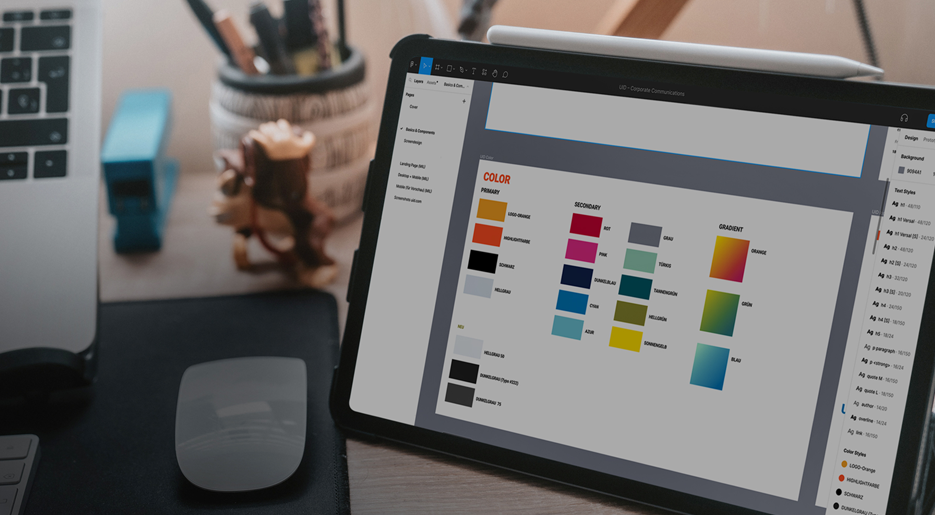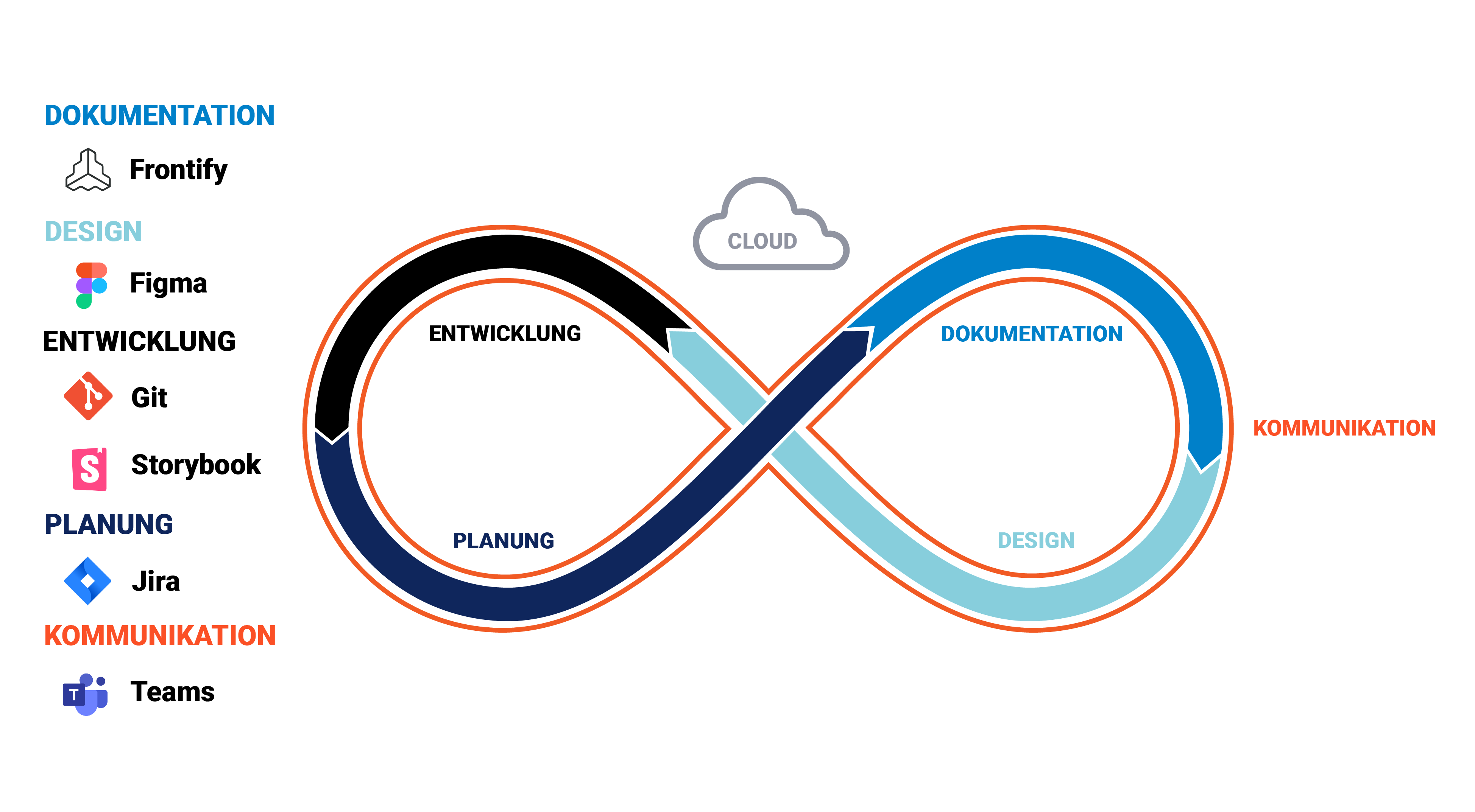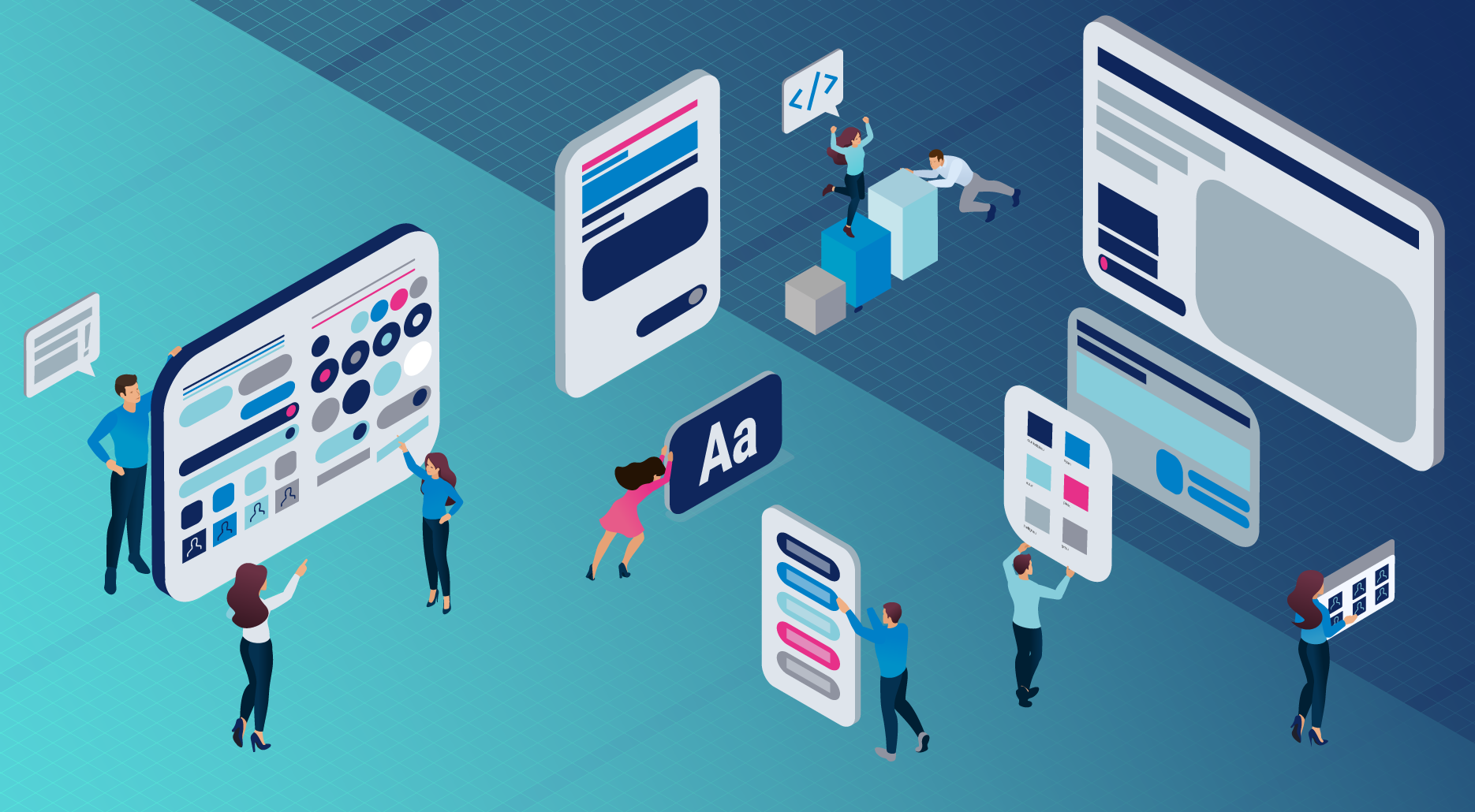25.07.2023
Top 10 FAQs on design systems
Digital design systems are an important building block for creating consistent and user-friendly digital product worlds in the long term. In our customer projects, we not only support the development of design systems, but also take care of establishing long-term strategies so that design systems are lived and used in the company.
In this article, we give you a deeper insight into the world of digital design systems. Based on their project experience, our design system experts Carina, Jasmin and Jenny have summarized the top 10 most important questions for you. Our FAQs relate to digital design systems (DDS for short) for the development of digital applications for companies. The term design systems is often used in a broader sense and refers to many more areas in brand identity design systems, such as print products and other aspects of brand communication.
1. What should I consider for a successful introduction of a design system?
A design system should be seen as a product and needs product managers, ideally a team. This design system team is responsible for anchoring the design system in the company and acts as an interface between the individual product and project teams. The tasks of this team include internal communication, further development of the design system and quality assurance of the results. Your design system is also very likely to be successful if you establish processes for communication, support and further development. Other important factors for long-term use are the targeted onboarding of product teams and the introduction of key performance indicators to measure success.
Tasks of a design system team at a glance:
- Internal communication
- Processes / regular meetings
- Quality assurance of results
- Control of the update process
- Monitoring and controlling progress
- Further development of the design system
2. What size should a design system team be?
You should appoint at least one responsible person in the company. This person has an overview of all topics relevant to the design system. If only one person is responsible for the design system, they should be able to get support from other disciplines. Ideally, however, a design system team should consist of several responsible persons from different areas of expertise.
3. When do I need a design system?
Whether a design system makes sense for a company depends primarily on the number of applications that need to be consistent and less on the complexity of a single product. Ideally, all of the company’s applications should be based on a design system – from the website to customer projects and internal administration tools.
Nevertheless, design systems are not always extensive and complex. In our projects, we often start by defining a design direction and a location for the documentation – this is also already a design system. A design system communicates the design principles, contains basic elements and perhaps also best practices. If your company is planning to develop new applications, it makes sense to create a basis for the design at an early stage, which can be expanded later.
4 How do I create a design system?
The best way to start is with a pilot project. From this project, you develop the basis for your design system: designs and interaction patterns are created in it – these are transferred to the design system for harmonization. The design system is gradually enriched and improved with the design of further products.
A design system can also be developed from an existing product. In this case, it is advisable to analyze the existing product or the various existing resources well before the actual design system documentation. This allows differences and similarities, visual principles and patterns that work well or less well to be identified. The key components that form the basis for future projects are then incorporated into the documentation.
From the outset, it is important that your management is behind the introduction of a design system and communicates this. The introduction of a design system is made more difficult if there is no official communication about the scope and binding nature of its use. Integration into existing processes and learning how to use a design system takes time – resources must be planned for this, which the teams are allowed to use.
5. How long does it take to set up a design system?

It depends on what information and preparatory work for a design system is already available in the company and the scope of your applications. If you start with a pilot project, you will first go through the user-centered design process. Parallel to the UX design of a new product, the content for the design system is created by deriving and documenting the basic components – i.e. typical controls and patterns of your product world. We anticipate a project duration of 9 to 12 months until version one of the design system is ready as part of a pilot project.
Alternatively, you can first set up the design system for the basic components only. To do this, you look at the existing applications and which components are already available and develop a design style for them. Very important: You should develop the design system in a current application, otherwise there will be no interaction between the components and therefore no uniform style. This creates a basic set of components that you can let the product team work with. In the next step, you then carry out a larger iteration of the design system. This approach can also be expected to take around 9 months.
It is also possible not to build the components yourself, but to use components from a library. The effort involved is of course less.
6. Which tool do I use to create my design system?
This depends on the focus of the design system. We have several criteria that we look at when choosing the right tool for creating a design system.
The first question is: Who will use the design system?
- If the design system is mainly used by developers, then tools that are structured more like developer tools (e.g. Knapsack, Zeroheight) are recommended. These tools support the provision of code snippets in different technologies very well.
- If you want to document not only design principles for digital products in the design system, but also all components that are used to communicate your brand to the outside world, then you need tools that cover the complexity of such a brand hub. Frontify is ideal for documenting design materials from different contexts. It is a comprehensive tool that allows you to create multiple areas. It can therefore be optimized for the different user groups (development, design, marketing, etc.). The look & feel in Frontify is easily customizable. This means you can also convey your brand identity in Brandhub.
Other questions that play a role in our customers’ decision for the right designsystem tool are
- Does the tool have a good integration of code snippets?
- Is it easy to edit? Are templates available for the documentation?
- How important is asset management?
- Should icons also be managed in the design system or is there a separate tool for this?

7. How do I make the design system understandable for non-designers?
Ideally using a real-life example! It can be helpful to run through certain scenarios using a specific application using the example of the non-design user group (e.g. marketing). This is the best way to create an awareness of what it means for the brand and products if everyone adheres to certain principles. Introductory events and introductory videos also help. We recommend offering various channels to introduce the design system.
8. How do I keep my design system consistent?
How can I keep my design system consistent if a lot of changes and adjustments are made later? No short-circuit reactions! Instead, it is better to invest more time in the analysis before making any changes. Here, too, the pilot project will help you to clarify the fundamental points. Basic decisions should be made before the design system is created. A design system team and defined processes for maintaining the design system are essential here.

9. How do I structure my design system for multiple products?
Many of our customers face this challenge. Depending on the product, the requirements of different user groups, target platforms and target devices must be taken into account in the design. There are two established variants for this:
- One option is individual documentation for each target platform. This makes sense if many or even all components differ due to different technologies, there are otherwise few overlaps apart from the design basics and the teams draw their information from the documentation largely independently.
- Another possibility is a common documentation for the same components and patterns, with respective jumps to the different uses in different target platforms.
10. Does the topic of accessibility belong in a design system?
The topic of accessibility definitely belongs in a design system when it comes to designing products in such a way that no one is excluded from using them. When the Accessibility Reinforcement Act (BFSG) comes into force in 2025, EU member states will be obliged to make certain products and services accessible and usable in future.
The topic of accessibility can be incorporated into the design principles, for example. Here we can document which accessibility standards we adhere to in the design and what different impairments need to be taken into account in the design.
The authors
Carina Völpel, Jenny Völpel and Jasmin Hellmann have over 25 years of combined experience in the user-centered design of user interfaces. They also advise many of our clients from a wide range of industries on the creation and successful introduction of design systems.

